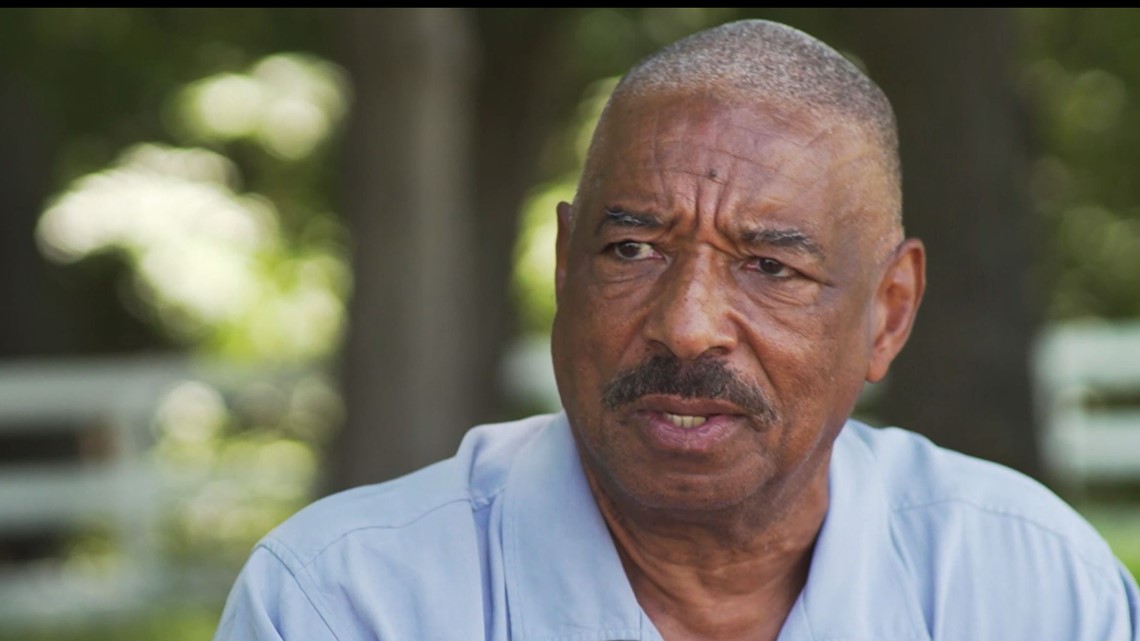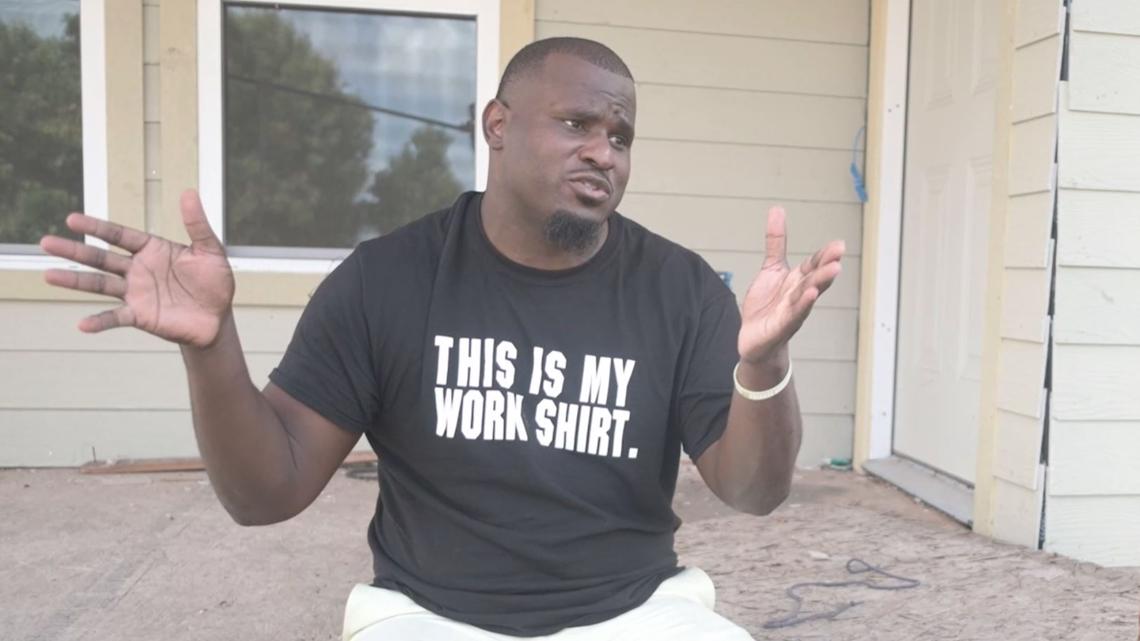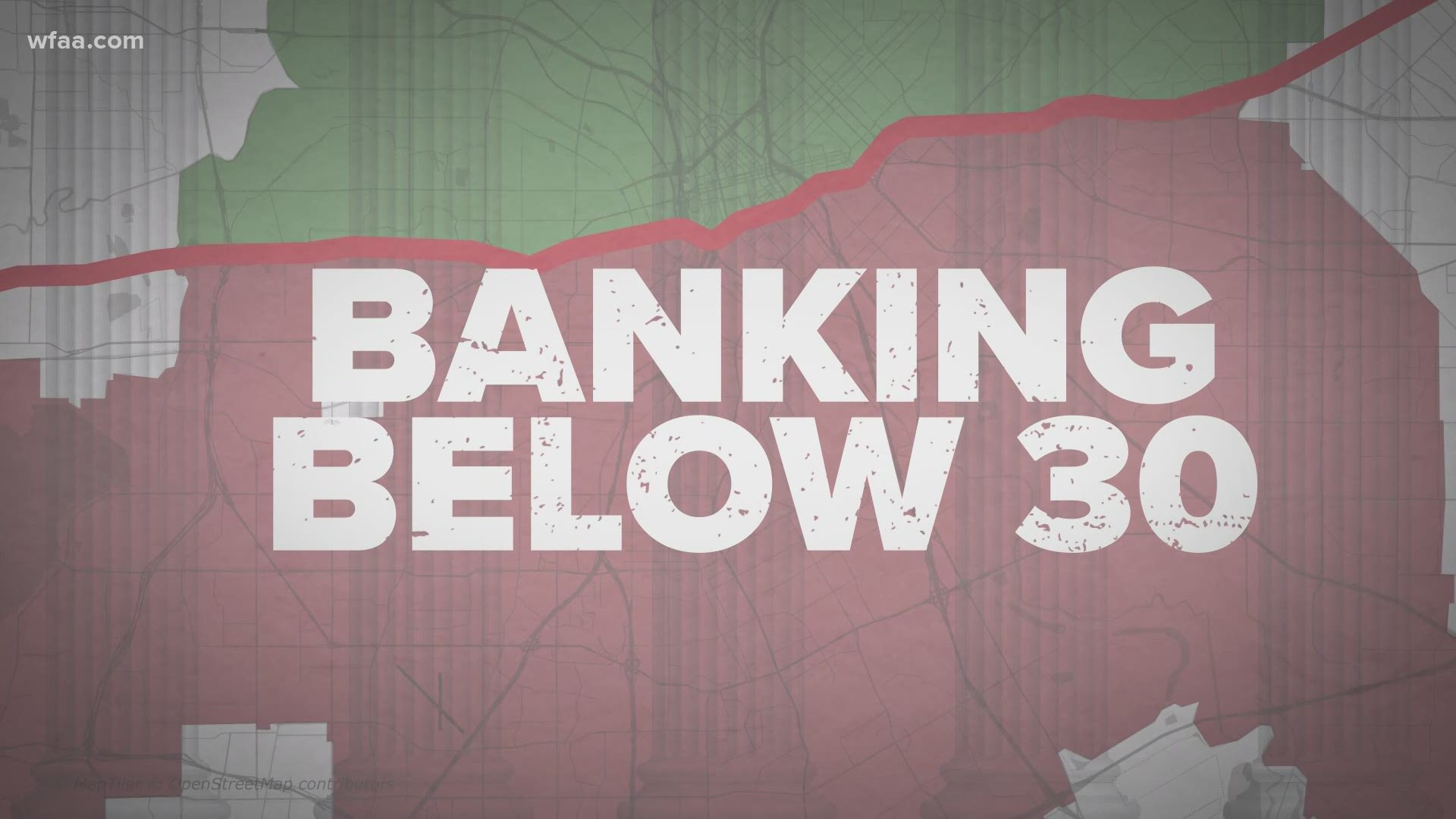DALLAS — For many people in Dallas, Interstate 30 is just a freeway.
But for many minority community leaders, it’s something else – an arbitrary boundary dividing the city’s mostly white population to the north from the city’s mostly Black and Hispanic communities to the south.
A WFAA investigation found that it is also a line that many banks use to determine who their customers are, and who they are not.
- Tips: Been treated unfairly by a bank? Click here and let us know.
It’s a topic with which North Texas has long struggled.
Consider the story of Robert Pitre. WFAA’s former longtime anchor John McCaa interviewed him for a 1988 documentary, “The Divided City,” which highlighted racial inequities.
The two talked about Pitre’s problems getting bank loans in southern Dallas. Pitre, back then, spoke about how he had to go to Houston to get financing for his business after seven local banks and savings and loans turned him down. Pitre said he sees his problems as typical -- wanting to expand but getting little or no support from financial institutions.
“In this community, it's an economic embargo,” Pitre said at the time. If banks were equitable, he said, “we wouldn't have a housing problem. We wouldn't have an unemployment problem. We wouldn't have a police problem."
Fast forward to 2020. We decided to find Robert Pitre and see how he’s doing. We found him in the same location, still selling cars in southern Dallas.


How are things? “Pretty much the same,” he said. “I would say worse.”
Thirty years later, Pitre has become quite successful. He now owns 132 acres of land in southern Dallas, including a large events center called Skyline Ranch. He said his success comes despite how hard it still is to get a loan.
“They underestimate what we can do as a people,” Pitre said.
North and south
North of I-30 is where 57 percent of the people in Dallas live – and where you'll find some of the whitest and wealthiest communities in North Texas, according to the Child Poverty Action Lab, based on U.S. Census data and data from the American Community Survey.
South of 30 is mostly Black and Hispanic people, with 38% of people living below the poverty line.
Some of the reasons for that go back to an old practice called redlining. This map, from 1937, literally colors minority communities red. For decades, banks used these maps to openly deny loans to minorities – mainly Black communities – and government said it was OK.
And how about today?
Consider the corner of the Dallas North Tollway and Northwest Highway, surrounded by some of the wealthiest neighborhoods in Texas. It’s overloaded with banks – 31 by our count.
A group called the National Community Reinvestment Coalition (NCRC) has tallied all the bank branches in Dallas County. Above I-30, there are 474. Southern Dallas has 58.
43 years ago, a fix
In 1977, Congress attempted to remedy the practice of redlining with what became called the Community Reinvestment Act. The CRA encouraged banks to meet the credit needs of the entire community where they operate.
“I think the bill … will provide us with a base or a framework on which we can make substantial improvements in the urban areas,” President Jimmy Carter said a day after he signed the bill.
He said he hoped the new law would “orient more and more of the rehabilitation money of all kinds to the more blighted areas of our country, both rural and urban.” He characterized it as an “assurance to people who live in those areas that we do indeed care.”
Under the CRA, each bank draws a map of what’s called its “assessment area,” which basically outlines where it does business. The law says a map must contain entire counties, cities, or towns, and cannot arbitrarily exclude low- or moderate-income geographies.
But the CRA recognized that some banks – depending on size or financial condition – might not be able to serve an entire area. In those cases, a bank may cut up a map along a significant barrier, such as a mountain, river or highway, as long as the new lines don't illegally discriminate.
James McGee was a compliance manager who helped banks follow the CRA’s rules. He now advocates for greater reinvestment in southern Dallas through a nonprofit called Southern Dallas Progress.


“I don't think it's actually working as it was intended,” McGee said of the CRA.
To find out how the CRA works, or doesn't, as McGee says, we asked every bank in Dallas County – 105 of them – to provide us their assessment area map.
We found that 20 percent of the banks in Dallas County draw maps that exclude some parts of southern Dallas. And all the maps got passing grades from bank regulators.
Click here to look through all the banks CRA evaluations and maps.
“I think it's discrimination,” McGee said. “You look at the demographic of people and where they're located and you're excluding them. I mean, I think it is discrimination.”
Maps
Dallas Capital Bank has a single branch in Dallas County just north of the Dallas North Tollway and Interstate 635. From this location, the bank provides services to all of Denton County and half of Collin, but does not serve the city of Dallas below I-30.
Dallas Capital Bank did not respond to multiple requests for comment.
Benchmark Bank has branches at Preston Road and Royal Lane, Hillcrest Avenue and Lovers Lane, and another on McKinney Avenue, just two miles north of I-30.
Benchmark drew a map that extends north into portions of Denton and Collin counties and picks up parts of Dallas' affluent Kessler Park and Bishop Arts neighborhoods in Oak Cliff, but little else below I-30.
“All areas conform to CRA regulatory requirements,” Benchmark told WFAA in response to questions about its map. “We are fortunate to support many charities impacting the youth and residents of Dallas on a daily basis. Impact areas include South Dallas, Fair Park, West Dallas, Central Dallas, and Pleasant Grove.”
Interbank’s two Dallas County branches are both located in northern Dallas, at Central Expressway and Mockingbird Lane, and the Dallas North Tollway and Lovers Lane. From those branches, Interbank drew a map that excludes virtually everything in Dallas County south of I-30.
To the south, Interbank also has branches in Ellis County, one of which is two miles from the Dallas County line. Interbank serves all of Ellis, Erath, Sommerville, Hood, Parker and Tarrant Counties. But only the northern half of Dallas County.
McGee said the maps looks that way because "they made a conscious effort to create it like that and that's going to be a senior management decision."
Interbank declined to comment for this story.
“An evaluation of the bank's fair lending activities was conducted during the examination to determine compliance with the substantive provisions of antidiscrimination laws and regulations," regulators with the Federal Reserve Bank of Kansas City wrote in the bank's evaluation in 2017. "No evidence of discrimination was identified. Furthermore, the bank has not engaged in any other illegal credit practices inconsistent with helping to meet community credit needs.”
But what does this all mean? Are banks actually lending to minorities? And does it make a difference if the bank has a map that includes southern Dallas, or not?
We asked the NCRC for help crunching some numbers. Banks are required to give the government demographic information about customers for their home loan products. While not all borrowers disclose race data, people who identify as white make up about half of these customers: 48 percent for banks whose assessment area maps include all of Dallas County, and 45 percent for banks that carve out southern Dallas, or significant portions of it.
The numbers for minority lending among these two groups of banks are stark. Banks that have all of Dallas County in their assessment area maps make 22 percent of their home-related loans to Hispanics, and 7 percent to Blacks. But banks with maps that cut off at I-30, as a group, make loans to minorities at lower rates – 8 percent to Hispanics and 2 percent to Blacks.
Extra credit
What are bank regulators doing about it?
Every few years, banking examiners grade institutions on how well they serve low-income communities and small businesses. Those grades are based on lending activity and investments inside the boundary of the banks’ maps.
Despite the reality on the ground, 98 percent of the time, regulators give banks a passing grade. McGee says that's happening because regulators are not scrutinizing how the maps are drawn. They just grade them on what happens inside the area the bank has hand-picked.
“It has to be judged harder by the regulator,” McGee said. “If we're in school and every class passes, I mean, I think there's something wrong with the test. The banks are going to be hard inclined to improve their current strategy. I mean, it's working and they're passing their exams.”
Click here for information on how to file a complaint against a bank.
Even though some banks are not doing business in the most disenfranchised parts of town, there are ways they can boost their CRA score to make up for it with banking regulators – extra credit, to continue the school analogy. This can take many forms – a bank executive working with a nonprofit in a low-income area, or lines of credit or grants given to community development corporations and other “qualified investments” that banks say benefit low- and moderate-income neighborhoods.
Texas Security Bank, for instance, got a satisfactory rating on its CRA evaluation. It has a map that extends farther south of Interstate 30 down to Interstate 20, but still excludes some of the city’s most low-income areas. In the bank’s public evaluation, regulators lauded a program call the TSB Academy, through which "… the bank provided technical assistance to small businesses and businesses in low- and moderate-income geographic areas."
We wanted to know more. The TSB Academy website shows it's a $1,200 training program for business executives – not low-income communities. The bank says it waives the fees for some applicants, and donates all fees from the academy to a Pleasant Grove school serving lower income families.
“In an effort to reach more diverse and low- and moderate-income borrowers, employees of the mortgage department actively engage in community outreach events,” said a Texas Security Bank spokesperson in a written response to our questions. These events include “meetings of the DFW Regional Housing Consortium, meetings with builders of affordable housing, and financial inclusion roundtables. Last year, the bank conducted an educational seminar for first time homebuyers at the Dallas Housing Fair,” the bank said.
Pegasus Bank also got a satisfactory CRA rating. Its map also doesn’t cover all of southern Dallas. In its evaluation, examiners gave the bank credit for spending $198,000 to form a community development corporation (CDC) "for the purpose of providing affordable housing within the assessment area to low- and moderate-income families."
We asked Pegasus Bank for details. They said the CDC owns one home in East Dallas that it says it rents out for below market rate.
When asked why the CRA evaluation leaves the impression that the effort was larger and helps “families,” a bank spokeswoman said the bank wants to buy more homes to rent but has been “unsuccessful in securing these opportunities.”
“We would really like to find an apartment complex in a low-income area that we can buy, improve, and maybe combine some of the one-bedrooms into larger units to be more accommodative to families,” said Alyson Trout of Pegasus Bank. “The brokers we have talked to are looking but have told us this type of property is in high demand and very scarce.”
The Texas Bankers Association, which represents about 400 banks across the state, said its members take the Community Reinvestment Act seriously.
"Proposed assessment areas must be approved or modified by federal banking regulators," said Chris Furlow, TBA President and CEO. "In areas where improvements can be made, the Texas banking industry stands ready to work with regulators, community organizations and Congress to make meaningful changes."
Furlow added that the CRA "does not tell the complete story of the commitment made by Texas banks — particularly community banks — to serving every community beyond CRA and other regulations." He cited the Paycheck Protection Program, the federal COVID-19 assistant program.
"Texas banks put their own liquidity at risk without firm guidance from the government to make the overwhelming majority of 417,000 loans in Texas totaling over $40.5 billion," Furlow said. "Those loans were a lifeline to small businesses across Texas and literally saved millions of jobs in nearly every community. It would not have been possible without our banks. And that is on top of millions of dollars contributed to food banks, charitable groups, and education initiatives. You would be hard pressed to find other industries that do as much as our community banks."
The regulators
Three different government agencies work together to evaluate banks for CRA compliance.
One is the Federal Reserve Bank, which declined to comment for this story. But it has publicly recognized the weaknesses of the CRA and is currently proposing rule changes.
The Federal Deposit Insurance Corporation – the FDIC – is another. A spokesperson said "if our examiners identify a pattern or practice of discrimination at an institution, the case is referred to the Department of Justice for appropriate action." A FDIC spokesperson did not respond to a follow-up question asking for instances where this has happened with Dallas-area banks.
The Office of the Comptroller of the Currency – the OCC – regulates big, national banks. The OCC has a new rule "requiring that assessment areas be no smaller than a whole county" that it says incentivizes “activities in underserved communities that may not immediately surround banks’ physical branch networks."
What happens in the rare instances when a bank gets a bad review?
Tolleson Bank, in Highland Park, is the only bank in Dallas County we could find with an overall score of "needs to improve.” While its map encompasses the whole county, regulators found the bank, which describes itself as focused “on the high net worth/high income segment of the personal banking market,” was doing a poor job distributing investments in low- to moderate-income neighborhoods.
“While we felt like we were doing an outstanding job giving back to the community within the spirit of the act, the often vague requirements of the CRA do not always reflect those efforts,” said Beatrice Kalish, spokesperson for Tolleson. “Therefore we decided to create a strategic plan that would be more reflective of our efforts with the goal of being able to be more impactful through credit and services within our resources and expertise.”
Today, Tolleson is the only bank in the county that publishes a strategic plan showing how it will reinvest $8.6 million dollars a year – 1.5 percent of its assets – into housing and education in needy communities.
None of what we found surprises Robert Pitre. He's been discouraged by banks his whole life. And just this January he sued one. Pitre claimed, because he's Black, a loan officer quoted him outrageous terms to make him go away.
“If I could be white during the day and turn back Black at night, I wouldn't have no problem borrowing money,” he said. “I could be wealthy.”

